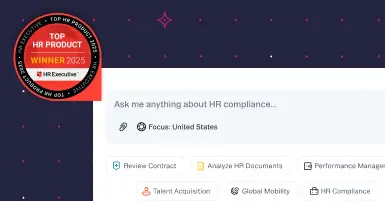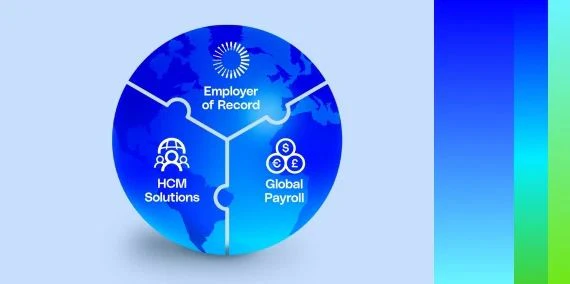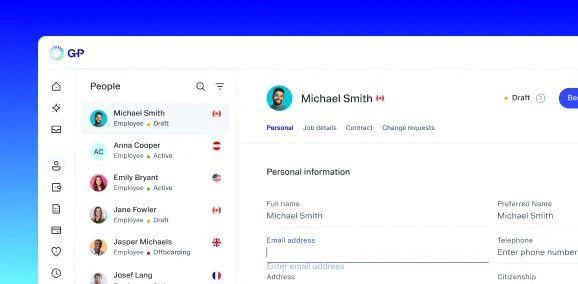Hiring in new countries helps your company stay resilient in a challenging economy. Whether you're onboarding employees or relying on contractors, formal agreements are crucial to protect your business and people. Every country has its own labor and employment laws, and worker misclassification is a huge risk.
Strong contracts minimize legal risks while setting clear expectations for every member of your global team. This guide explains the types of employment contracts so you can make smart choices for each hiring location and type of worker.
What is an employment contract?
An employment contract is a legal agreement between an employer and employee. It explains the terms and conditions of work, including job duties, pay, benefits, work hours, confidentiality, intellectual property rights, and work arrangements. An employment contract protects you and your team members from misunderstandings by defining each party's rights, responsibilities, and expectations.
What are the different types of employment contracts?
Several types of employment agreements exist. Understanding the purpose and elements of each one helps you choose the ideal employee work contracts for your global team.
1. Indefinite employment contract
An indefinite contract, also known as a permanent or open-ended contract, is the standard for employment contracts. It has no set end date. Employees under indefinite contracts often have greater legal protections regarding termination, severance, and redundancy compared to those on fixed-term contracts. You can end the contract but must follow local rules for terminating the employment relationship, including providing notice and severance benefits.
2. Part-time employment contract
A part-time contract is for roles with fewer hours than full-time, usually fewer than 30–35 hours per week. Part-time team members may get prorated benefits. For example, in Australia, both full-time and part-time employees get PTO based on their standard weekly hours. So an employee working 20 hours per week gets 80 hours of annual leave (4 weeks × 20 hours).
This contract gives you and your team members more flexibility. You can use part-time employment agreements to cover peak hours when you need more staff or want to fill ongoing roles that don't require 35+ hours per week.
3. Fixed-term employment contract
A fixed-term contract has a clear start and end date. It's ideal for projects, seasonal work, or a temporary hire to cover someone on leave. The contract ends automatically unless you renew it. Fixed-term employees often get the same benefits as permanent team members, but only for the duration of the contract.
Many countries, such as the Philippines, have regulations to prevent "rolling" or "serial" fixed-term contracts. Rolling contracts are when you create a new fixed-term contract each time the previous one expires, rather than offering the employee a permanent position.

4. Temporary employment contract
A temporary contract is a broad term for all types of agreements covering short-term work needs. Fixed-term contracts fall in this category, but it might also include casual contracts, seasonal work, or contracts that end when a certain event occurs (not always with a set date). For example, a temporary contract could end when funding for a role runs out, such as in grant-funded research positions.
5. Casual employment contract
A casual contract is for work on an as-needed basis. There are no guaranteed hours or long-term commitments. This is common in industries with fluctuating demand, such as hospitality or retail. In Australia, casual employees get a higher "casual loading" hourly rate instead of benefits. Employees under casual employment contracts can accept or decline shifts.
6. Collective Bargaining Agreement (CBA)
While not an employment contract, a Collective Bargaining Agreement (CBA) is a contract between an employer (or a group of employers) and a group of employees that are typically represented by a trade union. It sets terms for pay, benefits, and working conditions. CBAs are common in many European countries and are legally binding. In some countries, a CBA applies to businesses within a certain industry. For example, CBAs in Germany cover many industries and set minimum standards for all employees within their sectors.
What is a contractor agreement?
A contractor or services agreement is for hiring a self-employed person or business as an independent contractor. It creates a client-contractor relationship rather than an employee-employer relationship. It's a commercial arrangement between two businesses (or a business and an individual) and has different requirements than employment agreements.
Contractors control how and when they work. They complete deliverables within an agreed timeline. They pay their own taxes and cover their own healthcare and other benefits. Contractors are generally not subject to employment laws, but misclassifying someone as a contractor when they function as an employee can lead to fines and back payment of employment taxes, costs, and benefits.
Are there other types of contracts?
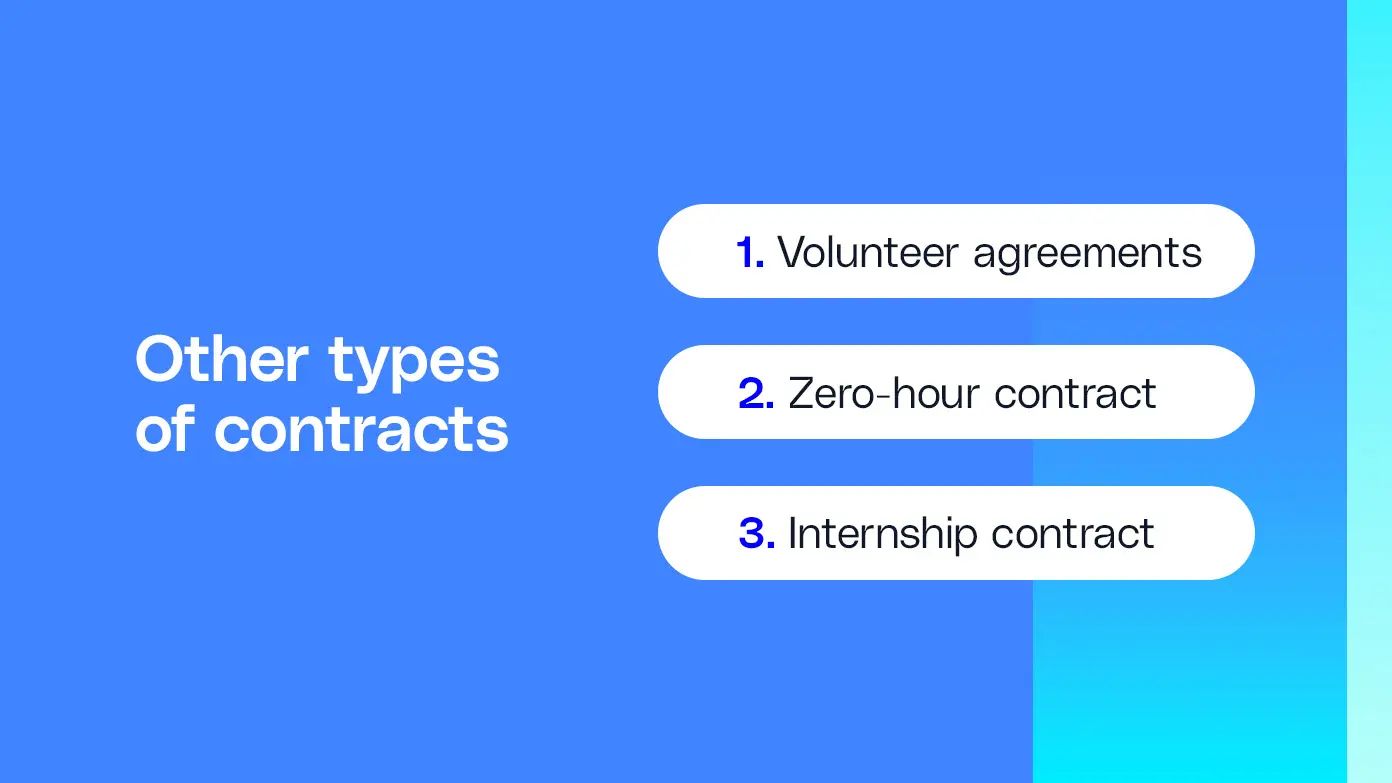
1. Volunteer agreements
These agreements cover unpaid roles, often in nonprofit or charitable organizations, and clarify expectations and responsibilities.
2. Zero-hour contract
A zero-hour contract doesn't guarantee any minimum hours. Your team member works only when needed and can refuse shifts. This contract type is allowed in the U.K., but is banned or restricted in other countries.
Unlike casual employment, zero-hour employment doesn't compensate employees for the lack of job security and unpredictable hours. Zero-hour workers are entitled to minimum or living wage and annual leave standards like other forms of U.K. employment.
3. Internship contract
Internship contracts offer practical experience and training for students or recent graduates. Internships can be paid or unpaid, depending on local laws. The country and specific arrangement will determine if internships are employment contracts or education arrangements. In countries like the U.K., unpaid internships are illegal unless the intern is part of an education or training program. This prevents employers from taking advantage of students or graduates to have profit-generating work done for free.
Formats for employment contracts
Along with the different types of employment contracts, you can use two main formats:
-
Written agreement: A written agreement is a signed document explaining all the terms of work, including job duties, pay, hours, and termination clauses. Written agreements are the most common and secure format. They give you clear evidence of the agreement. Many countries require written agreements by law, especially for global hires.
-
Verbal or implied contracts: An implied or verbal contract is based on spoken words rather than a written document. For example, if you tell someone you'll pay them a set salary for 40 hours per week and they work those hours consistently, you have a verbal or implied contract to continue paying them at this rate. These can be legally binding in many countries, but they're hard to prove and enforce.
Written agreements are always safer, especially for global teams.
How to choose the right employment contract
Choosing the right employment contract is key to building a strong, compliant team. Here's how to make the best choice for your business:
-
Assess the role's duration: Use a fixed-term or temporary agreement for short-term projects and an indefinite agreement for ongoing roles.
-
Think about supervision and control: Consider how much you'll direct the person's work. If you need to manage the person's day-to-day work, use an employment contract. If you want a contractor who controls how and when they work but commits to delivering an outcome, use a services agreement.
-
Review employment laws: Every country has its own rules for employment contracts, benefits, and termination. For example, zero-hour contracts are legal in the U.K. but banned in Germany and France. Some local and state jurisdictions also differ. Always check local laws before you draft a contract.
-
Confirm classification: To confirm whether a worker is an employee or a contractor, look at how much control you have, who provides the tools, and how you manage payments. Misclassifying someone as a contractor when they're an employee can lead to fines and back pay.
-
Evaluate flexibility versus job security: If you need flexibility, consider casual, temporary, or zero-hour contracts. If you want to build loyalty, retention, and workforce stability, use indefinite or part-time agreements.
-
Factor in benefits, compensation, and statutory minimums: Some agreements must include full benefits, such as indefinite contracts. Others, such as contractor or casual contracts, may offer limited or no benefits. Follow all local laws for pay, leave, and insurance for your intended agreement type.
-
Align agreements to strategy: Different work agreement types suit different business strategies. For example, you could use fixed-term contracts or service agreements to test new markets or for specific projects.
-
Consult the experts: When hiring in new locations, connect with an employer of record (EOR) that has legal and HR expertise in the region. They can ensure compliance and recommend the best work arrangements for your strategies.
10 tips for creating compliant employment contracts
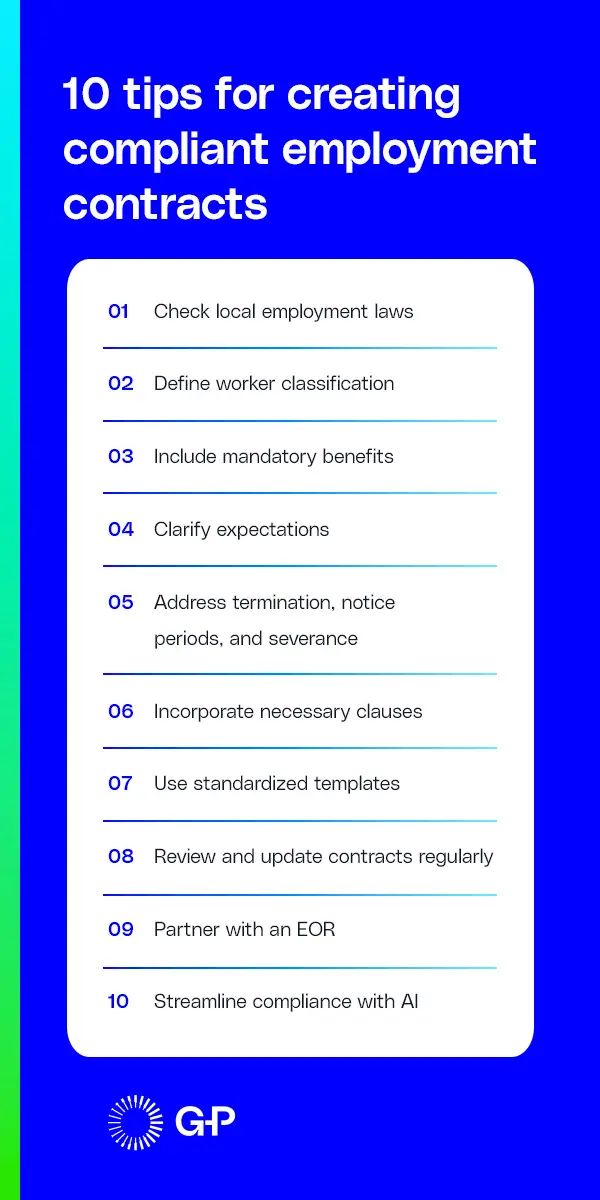
Compliance is the foundation of every work agreement. These 10 tips will help you create compliant contracts and protect your business:
-
Check local employment laws: Start by understanding the legal landscape where you want to hire. In Australia, contracts must meet the Fair Work Act's minimum standards for pay, leave, and termination. Australia also enforces the National Employment Standards for most employees.
-
Define worker classification: Misclassifying employees as contractors can lead to significant penalties and liability. Use local definitions and clear criteria, including payment structure and control over work conditions, to decide if someone is an employee or a contractor.
-
Include mandatory benefits: Most countries have statutory minimums for employment benefits, compensation, and leave. In the U.K., this includes statutory sick pay, holiday pay, and pension contributions. In the Philippines, mandatory benefits include 13th-month pay for certain employees, social security contributions, and national health insurance enrollment.
-
Clarify expectations: Outline the professional's role, responsibilities, and who they report to. This clarification avoids confusion and sets clear expectations.
-
Address termination, notice periods, and severance: Explain what each party should do if they want to end the agreement. For example, the Philippines mandates severance pay for qualifying employees who lose employment due to redundancy, retrenchment, or other reasons outside their control.
-
Incorporate necessary clauses: Include confidentiality, noncompete, intellectual property, and jurisdiction clauses relevant to the employee's role and location.
-
Use standardized templates: Contract templates save time, but remember to tailor them to each country's laws and expectations.
-
Review and update contracts regularly: Laws change, so review contracts periodically or any time you expand to a new country.
-
Partner with an EOR: Choosing an EOR with a global entity infrastructure and legal and HR expertise in your hiring location is the best way to reduce your risk, save time, and ensure compliance. With G-P EOR, you can create, update, and manage compliant contracts in 180+ countries.
-
Streamline compliance with AI: G-P Gia™ is an AI-powered global HR agent that can cut the time and cost of compliance by up to 95%. Gia provides real-time answers to your compliance questions, references up-to-date local laws, and generates and updates contract templates for 50 countries and all 50 U.S. states.
Hire anywhere quickly and compliantly with G-P™
We ensure the right classification, the right agreement, and ongoing compliance with local laws, so you can scale globally with confidence.
G-P EOR automates contract generation with a built-in global compliance engine and streamlines onboarding workflows with our in-platform AI, G-P Assist, so you can build global teams in minutes. For HR and legal teams looking for instant answers on global employment contract compliance, Gia offers on-demand guidance and contract review across 50 countries and all U.S. states.
Book a demo today to discover how our solutions can simplify global work agreements for your company.


